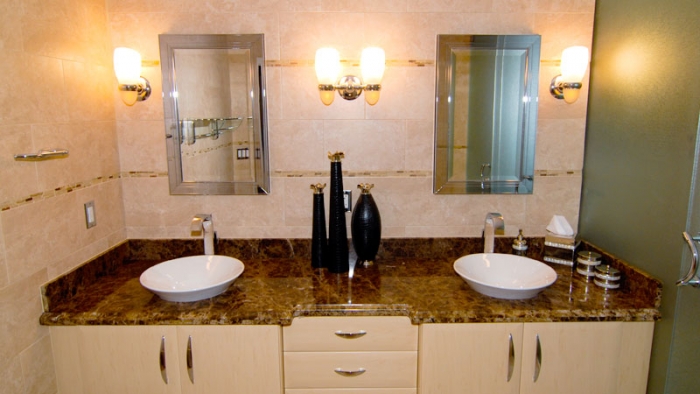How much space do you have?
It's essential to measure your bathroom before making a purchase. Consider how much counter space and storage space you will need. Also make sure to note the dimensions of the area where your bathroom vanity will be installed. The width and depth are often fixed measurements due to the physical space in your bathroom, but you can typically have more freedom in selecting the height.
- Overall Width: This is the side to side measurement of the vanity top.
- Overall Height: This depends on any mirror or medicine cabinet that may already be installed above the vanity, as well as your personal preference.
- Overall Depth: For a narrower bathroom, vanities with a smaller depth are necessary. Make sure to consider any interference with the entryway, storage drawers, or shower doors.
How many sinks do you need?
If space is not a factor in choosing a vanity, the number of sinks is preferable.
- Single Vanities: Most common. For small spaces, vanities with one sink are the best option. For ample counter space, single vanities with a large width are best.
- Double Vanities: Perfect for a shared or family bathroom. Two sinks are generally best accommodated by a width of at least 48" or more.
Which mounting options are available?
- Free Standing: Also known as standard, this is the most common bathroom vanity. It resembles a chest or buffet, and is your best option for maximum storage space.
- Wall-Mounted: Most wall-mounted vanities hang or float on the wall without legs touching the ground. This modern style opens up floor space in a small bathroom.
- Corner-Mounted: If you need to save space, this is the best option. Corner-mounted bathroom vanities have a 90-degree angle at the back so that they fit perfectly into a corner.
What type of sink would you like?
When choosing a sink type, you should consider vanity style, counter space, and overall style of the bathroom.
- Undermount: This sink is designed to be installed under the counter for a cleaner appearance. Because there are no exposed edges, this style makes countertop cleanup easy and fuss-free.
- Self-Rimming: Also known as a top-mount or drop-in, this style is mounted directly into an opening on the counter, with its edges resting on it.
- Vessel: Typically bowl-shaped units that sit on top of the counter surface. They do not require undermount installation.
How do you want to customize it?
- Style: The style of your vanity should complement the rest of your decor. Consider a contemporary vanity for an option that will match most bathroom styles.
- Contemporary: Simple, clean-lined designs that will work with a wide variety of styles
- Modern: Streamlined designs with clean styling and sometimes sharp angles or bold shapes
- Traditional: Classic designs with detailed elements, such as panel doors, ornate carvings, and rich wood
- Rustic: Relaxed or more casual designs that highlight the natural beauty of raw materials, such as wood, iron, and stone
- Finish: Most vanity tops come in a variety of finish and material options that you can tailor to your bathroom style, such as ceramic, stone, glass and wood.
- Material: Choose between a wide range of base and sink materials to match the decor of your bathroom. Base cabinets come in hardwood, manufactured wood, metal, or glass. Sink materials are mostly made of ceramic, stone, or glass.
- Storage: Consider what type of bathroom the vanity will be going in to determine your storage needs, such as a master bath, guest bathroom, or kids' bathroom. There are a number of options including drawers, shelves, and cabinets.
- Hardware: The majority of vanities do not come with sink faucets and handles, but some do if you read in the description. This is another opportunity to customize the look of your bathroom.
- Backsplash or Sidesplash: Consider whether or not you will need a sidesplash or backsplash to make the vanity work in your space. If so, focus on brands that either include these pieces with the vanity or sell them separately. If you purchase these separately, ensure that the finish and dimensions match the vanity top. For a backsplash, the length of the backsplash should match the length of the vanity top and with a sidesplash, the length of the sidesplash should match the width of the vanity top.
What other factors should I consider?
- Collections: Consider coordinating collections in order to maintain a cohesive look. Often sinks, mirrors, or medicine cabinets are sold separately but are a part of the same collection and style.
- Faucets: The majority of vanities do not come with the faucets included. However, most vanity tops come pre-drilled with faucet holes, depending on your sink style.
- Accessories: Bath accessories are an important asset to complete the look of any new vanity. Most sets include lotion pumps, soap dishes, toothbrush holders, and tumblers.

